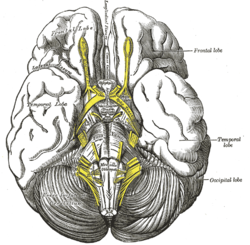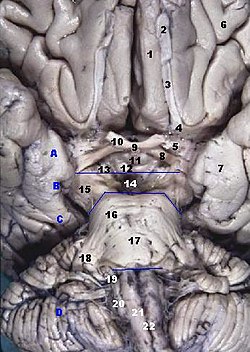Diagonal band of Broca
| Diagonal band of Broca | |
|---|---|

Base of brain. (Diagonal band of Broca not labeled, but anterior perforated substance labeled at center.)
|
|

Human brainstem, anterior view. (Diagonal band of Broca not labeled, but anterior perforated substance is #5.)
|
|
| Details | |
| Identifiers | |
| Latin | stria diagonalis |
| MeSH | A08.186.211.730.885.380 |
| NeuroNames | hier-267 |
| NeuroLex ID | Diagonal band |
| Dorlands /Elsevier |
s_26/12762750 |
| TA | A14.1.09.422 |
| FMA | 61973 |
|
Anatomical terms of neuroanatomy
[]
|
|
The diagonal band of Broca is one of the basal forebrain structures that are derived from the ventral telencephalon during development. This structure forms the medial margin of the anterior perforated substance.
It consists of fibers that are said to arise in the parolfactory area, the gyrus subcallosus and the anterior perforated substance, and course backward in the longitudinal striae to the dentate gyrus and the hippocampal region.
This is a cholinergic bundle of nerve fibers posterior to the anterior perforated substance. It interconnects the paraterminal gyrus in the septal area with the hippocampus and lateral olfactory area.
The nucleus of diagonal band is a structure in the brain. It projects to the hippocampal formation through the fornix.
Along with the septum pellucidum and medial septal nucleus, the diagonal band of Broca is believed to be involved in the generation of theta waves in the hippocampus.
Its behavior can be altered by nerve growth factor.
This article incorporates text in the public domain from the 20th edition of Gray's Anatomy (1918)
...
Wikipedia
